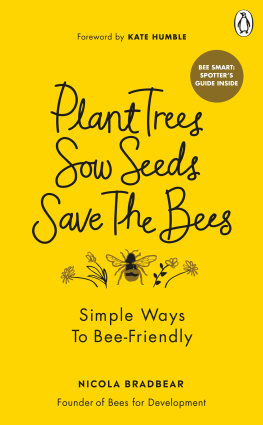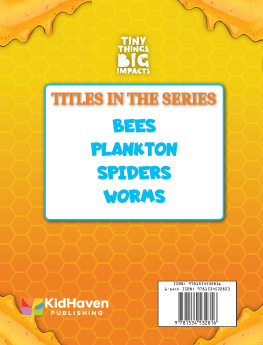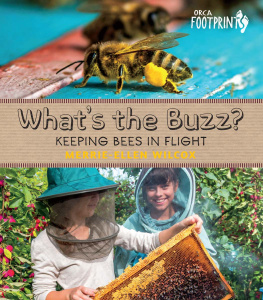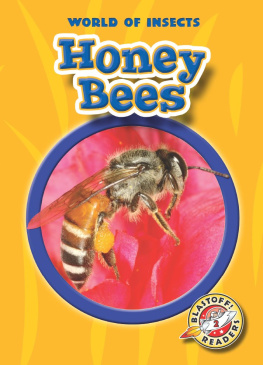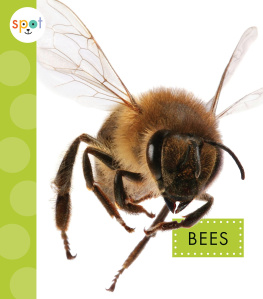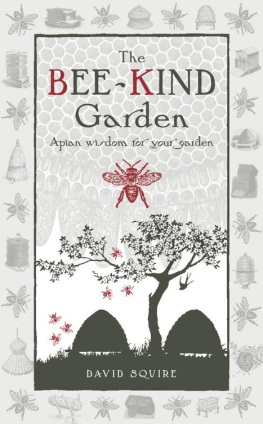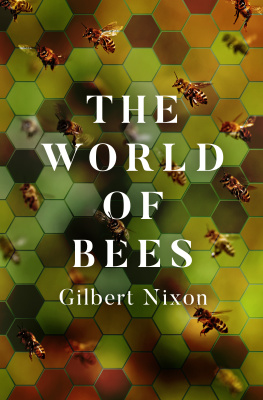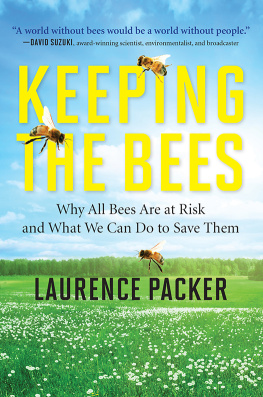
The Bee-spotters Guide
Inside the cover you will see a spotters guide to help you to identify the types of striped friends featured in this book. You can use the checklist on to tick them off as you spot each one, and get to know your stripey neighbours. Read on to find out what makes them so special and what you can do to help them thrive.
EBURY
UK | USA | Canada | Ireland | Australia
New Zealand | India | South Africa
Ebury is part of the Penguin Random House group of companies whose addresses can be found at global.penguinrandomhouse.com.

First published by Witness Books in 2021
Text copyright Nicola Bradbear 2021
Illustrations Eleanor Crow 2021
Flowers and chapter header bee illustrations
by Two Associates Witness Books 2021
The moral right of the author has been asserted
Cover design by Two Associates
Colour origination by Altaimage Ltd, London
ISBN: 978-1-473-58655-0
This ebook is copyright material and must not be copied, reproduced, transferred, distributed, leased, licensed or publicly performed or used in any way except as specifically permitted in writing by the publishers, as allowed under the terms and conditions under which it was purchased or as strictly permitted by applicable copyright law. Any unauthorized distribution or use of this text may be a direct infringement of the authors and publishers rights and those responsible may be liable in law accordingly.

Foreword
Bugs. Creepy crawlies. Pests.
Insects are perhaps the least loved and most underappreciated members of the animal kingdom. In fact, we humans spend quite a lot of time and money on repellents and insecticides trying to banish insects from our lives and weve been quite successful.
A recent study found that more than 40% of insect species are declining and a third are endangered. The total mass of insects is falling by 2.5% a year, according to the data, and if that continues, within a century they could all be gone. But given that we dont love insects very much, would that be a bad thing?
Well, yes. It would be a very bad thing, because without insects, many of the things we do love trees, flowers, birds and a whole host of cuddly, furry, adorable animals wouldnt exist at all. And in fact, neither would we. By helping bring about the end of insects, we are speeding up our own extinction. Because insects are both food for a host of other species, and pollinators of the plants that are eaten by everything from elephants to dormice, orangutans to us humans.
Like it or not, we need insects, and for all of us to thrive we need to treat them, not as foes, but as the much-needed friends and allies they are. Luckily, our insects have a champion. The author of this book, Nicola Bradbear, has made it her lifes work to educate communities all around the world on the importance of insects, particularly stripey ones. As founder and director of the charity Bees for Development, she has worked as an adviser and consultant all over the world.
In Monmouthshire, where she lives and where the charity is based, Nicola helped to establish the Bee Friendly Monmouthshire campaign group to address the dramatic decline in numbers of honey bees, bumblebees and other pollinators such as wasps and hoverflies, moths and butterflies.
Visit the county and you will notice that many of the verges, roundabouts and other small parcels of land have been planted with wild flowers to provide food and habitat for these vital insects. You will also notice how beautiful it is to have wild flowers along our roadsides. We benefit as much as the insects.
By buying this book, you can start to get to know some of our stripey insect friends and to appreciate how much they enrich so many aspects of our lives. But I also hope that you will be inspired to become an insect champion and encourage others to do the same, because the rewards will be many, and it will definitely give you a bit of a buzz !
Kate Humble


Introduction: Why do we need insects?
The plant life on our planet flourishes thanks to the labour of insects. From dawn to dusk, hour after hour, day after day, our insects are ferrying pollen from one flower to another. This work enables flowering plants to create their seeds, to bear fruit, and means that future generations of plants will continue to thrive. Most of the fruit, vegetables and crops that we rely on for food, and that feed animals, too, rely on this busy process.
Next time you step outside, look for some flowers any flowers, anywhere. If they are real (not plastic or nylon!), you should find some insects feeding on them. That is why those flowers exist to attract insects to the plant, and no other reason. The insects are feeding, and at the same time they are pollinating the plant, enabling it to produce seed for the next generation of plants, to feed the next generation of bees, and everything else.
Once you begin to notice them, youll see bees and other stripey insects constantly searching out every useful flower.
Every scrap of earth can support a few flowers, which will in turn support a few insects, which will pollinate more plants and support a few birds, too. Flowers and insects are at the beginning of long food chains that support biodiversity, and right now the worlds capacity to produce food is being undermined by our failure to protect them.
Stripey insects, including bees and many other insects (and not just the stripey ones), are incredibly important for continued life on Earth. We know that they pollinate our food crops, but that is just one of the crucial services that they carry out for us.
- Insects are a vital part of the food chain: they are the food that supports populations of larger animals birds, bats and other insect-eaters, like amphibians and fish.
- They work to keep everything decomposing nicely, eating waste and unlocking nutrients to keep the natural cycle going.
- Insects are important pest controllers for example, wasps, hoverflies and ladybirds feed on aphids and greenfly. They are the gardeners friends.
- They are important soil engineers for example, ants keep the soil aerated and healthy for plants to grow.
- Creatures of beauty insects moving from flower to flower are wonderful to see and bring us joy. It is hard to imagine that joy ending completely, so we must do all we can to preserve them.
Depending on where you live, you will have your own range of stripey insects. The only one that exists almost everywhere on Earth and that you are highly likely to see is the honey bee, which people have transported from where it lives naturally to almost every nation. The European wasp and some bumblebee species have been transported by us outside their natural distribution range, too for example, the European wasp has been common in New Zealand since the 1940s. Otherwise, you will see your own local species of bees, wasps and hoverflies that are similar to, but different from, those illustrated in this book. If you live in a temperate climate you will see bumblebees although they do not occur naturally in Southern Africa, Australia or New Zealand, where you have other special bees occupying their niche. For example, in Australia you will see amazing blue-banded bees, carpenter bees living in dead wood, and many other social and solitary species. North America has its own species of shiny blue-black carpenter bees, and many species of mining bees and leaf-cutter bees the same but different from those described in this book.
Next page
